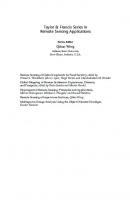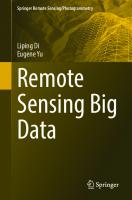Simulation of the Sea Surface for Remote Sensing 3030587517, 9783030587512
This book considers the formation of the signal reflected from the sea surface when sensing in the radio and optical ran
308 87 8MB
English Pages 222 [233] Year 2020
Table of contents :
Introduction
Contents
1 Statistical Distributions of Sea Surface Elevations
1.1 Introduction
1.2 Possibilities and Limitations of the Gram-Charlier Distribution
1.3 Combined Distribution Model
1.4 Sea Surface Cumulant Variability
1.5 Testing of the Gram-Charlier Distribution
1.6 Statistical Models of the Nonlinear Wave Field
1.7 Conclusion
References
2 Statistical Distributions Sea Surface Slope
2.1 Introduction
2.2 Two-Dimensional Laser Slopemeter
2.3 Statistical Characteristics of Sea Surface Slope
2.3.1 Distribution of a Weakly Non-linear Wave Field
2.4 Dependence of Slope Statistics on Wind Speed
2.5 Anisotropy of Sea Surface Slope
2.6 Modeling the Probability Density Function of the Slope of the Sea Surface
2.6.1 Opportunities and Limitations of Distributions Based on Truncated Gram-Charles Series
2.7 The Longuet-Higgins Model
2.8 Two-Component Conditional-Normal Distribution
2.9 Sea Surface Slope Module
2.10 Statistics of Sea Surface Slope in Areas of Slicks and Ripples
2.11 Characteristics of Sea Surface Slope in Natural and Artificial Slicks
2.12 Conclusion
References
3 On the Dispersion Relation of Sea Waves
3.1 Introduction
3.2 Wave Measurement Equipment and Measurement Conditions
3.3 Measurements of the Quadratic Coherence Function on the Scale of the Dominant Waves
3.4 Comparison of Results of Field and Laboratory Experiments
3.5 Modeling of the Quadratic Coherence Function
3.5.1 Angular Distribution Effect of Wave Energy
3.5.2 Effect of the Presence of Longwave Harmonics
3.5.3 Group Structure Effect
3.6 Calculation of Angular Distribution Functions
3.7 Conclusion
References
4 Modeling the Shape of the Impulse Reflected from the Sea Surface
4.1 Introduction
4.2 Brown’s Model
4.3 Sea Surface Elevation Probability Density Function Models
4.4 Reflected Impulse Shape Calculation
4.5 Errors in Sea Surface Level Determination
4.6 Physical Limitations of Spatial Resolution of Spaceborne Radio Altimeter
4.7 Errors in the Determination of Sea Surface Characteristics Due to the Group Structure of Surface Waves
4.8 Conclusion
References
5 Effect of Long Surface Waves on the Bragg Scattering of Microwave
5.1 Introduction
5.2 Bragg Scattering of Radio Waves by the Sea Surface
5.3 Statistical Characteristics of Sea Surface Slopes
5.4 Sounding of the Sea Surface in the Centimeter Range of Radio Wave
5.4.1 Numerical Estimates of Changes in the Length of the Bragg Component
5.4.2 Effect of Long Waves on the Bragg Scattering (Gaussian Distribution)
5.4.3 Effects of Quasi-Gaussian Distribution of Sea Surface Slopes
5.5 Sounding of the Sea Surface in the Millimetre Range of Radio Wave
5.6 Conclusion
References
6 Impact of Physicochemical Characteristics of the Sea Water on Bregg Scattering of Radio Waves
6.1 Introduction
6.2 Dependence of the Complex Dielectric Constant of Water on Its Temperature and Salinity
6.3 Bragg Scattering Radio Wave
6.4 Dependence of Geometric Coefficient on Water Temperature and Salinity
6.5 Determination of Seawater Temperature and Salinity by Active Ocean Sounding Instruments
6.6 Variability of Polarization Ratio
6.7 Conclusion
References
7 Measurements of Statistical Moments of Sea Surface Slope Based on Satellite Sounding Data
7.1 Introduction
7.2 Bidirectional Reflection Distribution Function
7.3 Restore Statistical Moments from Optical Scanners
7.4 Laser Sensing of the Sea Surface from a Satellite
7.5 Conclusion
References
8 The Distribution of the Variance of the Sea Surface Slopes on the Spatial Scales Creating Their Waves
8.1 Introduction
8.2 Variances of Slopes of the Sea Surface
8.3 Radar Determination of Slope Variance
8.4 Radiometric Determination of Slope Variance
8.5 In Situ Slope Measurements
8.6 Comparison of Variances of Slopes of the Sea Surface
8.7 Calculation of the Distribution of Surface Variances Based on Spectral Model
8.8 Conclusion
References
9 Study of the Variability in the Ocean-Atmosphere Interface as a Reflective Surface of Light
9.1 Introduction
9.2 Measuring Equipment and Measurement Conditions
9.3 The Possibility of Determining the Slope of the Sea Surface by Indicating the Reflective Reflections of a Mirror
9.4 Statistical Connection of Laser Glint Characteristics and Wave Field Characteristics
9.5 Conclusion
References
10 Physical Limitations of Accuracy of Remote Determination of Wind Speed Over the Ocean
10.1 Introduction
10.2 Altimetric Determination of Wind Speed
10.2.1 Radio Altimeter Signal Conditioning
10.2.2 Evaluation of the Error in Determining Wind Speed Based on in Situ Measurements
10.2.3 Estimation of the Error in Determining Wind Speed Based on Sounding Data of the Sea Surface in the Optical Range
10.2.4 Two-Parameter Recovery of Altimetric Wind
10.3 Scatterometer Determination of Wind Speed
10.3.1 Short Wave Energy Versus Wind Speed
10.3.2 Long Wave Effect
10.4 Conclusion
References
Introduction
Contents
1 Statistical Distributions of Sea Surface Elevations
1.1 Introduction
1.2 Possibilities and Limitations of the Gram-Charlier Distribution
1.3 Combined Distribution Model
1.4 Sea Surface Cumulant Variability
1.5 Testing of the Gram-Charlier Distribution
1.6 Statistical Models of the Nonlinear Wave Field
1.7 Conclusion
References
2 Statistical Distributions Sea Surface Slope
2.1 Introduction
2.2 Two-Dimensional Laser Slopemeter
2.3 Statistical Characteristics of Sea Surface Slope
2.3.1 Distribution of a Weakly Non-linear Wave Field
2.4 Dependence of Slope Statistics on Wind Speed
2.5 Anisotropy of Sea Surface Slope
2.6 Modeling the Probability Density Function of the Slope of the Sea Surface
2.6.1 Opportunities and Limitations of Distributions Based on Truncated Gram-Charles Series
2.7 The Longuet-Higgins Model
2.8 Two-Component Conditional-Normal Distribution
2.9 Sea Surface Slope Module
2.10 Statistics of Sea Surface Slope in Areas of Slicks and Ripples
2.11 Characteristics of Sea Surface Slope in Natural and Artificial Slicks
2.12 Conclusion
References
3 On the Dispersion Relation of Sea Waves
3.1 Introduction
3.2 Wave Measurement Equipment and Measurement Conditions
3.3 Measurements of the Quadratic Coherence Function on the Scale of the Dominant Waves
3.4 Comparison of Results of Field and Laboratory Experiments
3.5 Modeling of the Quadratic Coherence Function
3.5.1 Angular Distribution Effect of Wave Energy
3.5.2 Effect of the Presence of Longwave Harmonics
3.5.3 Group Structure Effect
3.6 Calculation of Angular Distribution Functions
3.7 Conclusion
References
4 Modeling the Shape of the Impulse Reflected from the Sea Surface
4.1 Introduction
4.2 Brown’s Model
4.3 Sea Surface Elevation Probability Density Function Models
4.4 Reflected Impulse Shape Calculation
4.5 Errors in Sea Surface Level Determination
4.6 Physical Limitations of Spatial Resolution of Spaceborne Radio Altimeter
4.7 Errors in the Determination of Sea Surface Characteristics Due to the Group Structure of Surface Waves
4.8 Conclusion
References
5 Effect of Long Surface Waves on the Bragg Scattering of Microwave
5.1 Introduction
5.2 Bragg Scattering of Radio Waves by the Sea Surface
5.3 Statistical Characteristics of Sea Surface Slopes
5.4 Sounding of the Sea Surface in the Centimeter Range of Radio Wave
5.4.1 Numerical Estimates of Changes in the Length of the Bragg Component
5.4.2 Effect of Long Waves on the Bragg Scattering (Gaussian Distribution)
5.4.3 Effects of Quasi-Gaussian Distribution of Sea Surface Slopes
5.5 Sounding of the Sea Surface in the Millimetre Range of Radio Wave
5.6 Conclusion
References
6 Impact of Physicochemical Characteristics of the Sea Water on Bregg Scattering of Radio Waves
6.1 Introduction
6.2 Dependence of the Complex Dielectric Constant of Water on Its Temperature and Salinity
6.3 Bragg Scattering Radio Wave
6.4 Dependence of Geometric Coefficient on Water Temperature and Salinity
6.5 Determination of Seawater Temperature and Salinity by Active Ocean Sounding Instruments
6.6 Variability of Polarization Ratio
6.7 Conclusion
References
7 Measurements of Statistical Moments of Sea Surface Slope Based on Satellite Sounding Data
7.1 Introduction
7.2 Bidirectional Reflection Distribution Function
7.3 Restore Statistical Moments from Optical Scanners
7.4 Laser Sensing of the Sea Surface from a Satellite
7.5 Conclusion
References
8 The Distribution of the Variance of the Sea Surface Slopes on the Spatial Scales Creating Their Waves
8.1 Introduction
8.2 Variances of Slopes of the Sea Surface
8.3 Radar Determination of Slope Variance
8.4 Radiometric Determination of Slope Variance
8.5 In Situ Slope Measurements
8.6 Comparison of Variances of Slopes of the Sea Surface
8.7 Calculation of the Distribution of Surface Variances Based on Spectral Model
8.8 Conclusion
References
9 Study of the Variability in the Ocean-Atmosphere Interface as a Reflective Surface of Light
9.1 Introduction
9.2 Measuring Equipment and Measurement Conditions
9.3 The Possibility of Determining the Slope of the Sea Surface by Indicating the Reflective Reflections of a Mirror
9.4 Statistical Connection of Laser Glint Characteristics and Wave Field Characteristics
9.5 Conclusion
References
10 Physical Limitations of Accuracy of Remote Determination of Wind Speed Over the Ocean
10.1 Introduction
10.2 Altimetric Determination of Wind Speed
10.2.1 Radio Altimeter Signal Conditioning
10.2.2 Evaluation of the Error in Determining Wind Speed Based on in Situ Measurements
10.2.3 Estimation of the Error in Determining Wind Speed Based on Sounding Data of the Sea Surface in the Optical Range
10.2.4 Two-Parameter Recovery of Altimetric Wind
10.3 Scatterometer Determination of Wind Speed
10.3.1 Short Wave Energy Versus Wind Speed
10.3.2 Long Wave Effect
10.4 Conclusion
References

- Author / Uploaded
- Alexander Zapevalov
- Konstantin Pokazeev
- Tatiana Chaplina
- Similar Topics
- Geography
- Meteorology, Climatology
![Simulation of the Sea Surface for Remote Sensing [1st ed.]
9783030587512, 9783030587529](https://ebin.pub/img/200x200/simulation-of-the-sea-surface-for-remote-sensing-1st-ed-9783030587512-9783030587529.jpg)

![Surface-Based Remote Sensing of the Atmospheric Boundary Layer [1 ed.]
9789048193394, 9048193397](https://ebin.pub/img/200x200/surface-based-remote-sensing-of-the-atmospheric-boundary-layer-1nbsped-9789048193394-9048193397.jpg)






